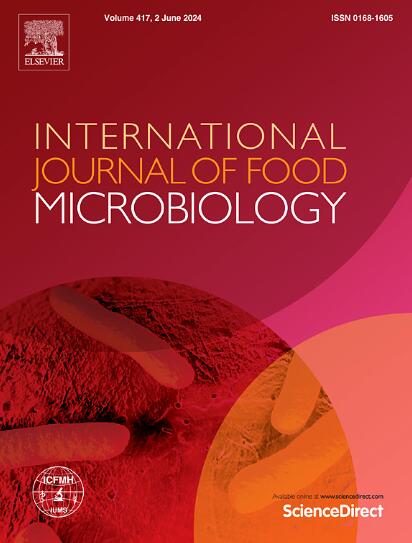香芹酚对鼠伤寒沙门菌的失活机理及其与405nm蓝光对鸡肉保鲜的联合抑制作用
IF 5.2
1区 农林科学
Q1 FOOD SCIENCE & TECHNOLOGY
International journal of food microbiology
Pub Date : 2025-05-21
DOI:10.1016/j.ijfoodmicro.2025.111276
引用次数: 0
摘要
鼠伤寒沙门氏菌(S. Typhimurium)是造成食品污染和食源性疾病的主要原因。本研究考察了天然化合物香芹酚(CAR)对鼠伤寒沙门氏菌(S. Typhimurium)的抑菌活性,并评价了CAR与405 nm蓝光(BL-405 nm)对鸡肉保鲜的联合抑菌效果。CAR具有良好的抑菌活性,最低抑菌浓度为0.5 mg/mL。2MIC时的CAR显著破坏细菌膜的完整性,导致细胞内内容物渗漏。CAR和BL-405 nm联合作用可显著降低鼠伤寒沙门氏菌活力5.62 log CFU/mL。抗菌机制研究表明,BL-405 nm和CAR通过产生活性羟基自由基(reactive hydroxyl radicals, OH)等高活性氧物质触发细胞氧化应激,导致细胞破坏,最终导致细胞死亡。在实际应用试验中,CAR结合BL-405 nm处理,通过保持鸡肉的水分含量、稳定pH值、保持颜色和质地、抑制微生物生长和脂质氧化,有效延长了鸡肉的保质期。该研究为CAR联合BL-405 nm对鼠伤寒沙门氏菌的抑菌机制提供了新的见解,为延长禽肉的货架期提供了新的策略。本文章由计算机程序翻译,如有差异,请以英文原文为准。
Inactivation mechanisms of carvacrol on Salmonella Typhimurium and its combined inhibitory effects with blue light-405 nm for chicken meat preservation
Salmonella Typhimurium (S. Typhimurium) is a major contributor responsible for food contamination and foodborne illnesses. In this study, the antibacterial activity of natural compound carvacrol (CAR) against S. Typhimurium were evaluated, and the combined inhibitory effects of CAR and blue light-405 nm (BL-405 nm) were also assessed for chicken meat preservation. CAR showed efficient antibacterial activity with a minimal inhibitory concentration (MIC) at 0.5 mg/mL. CAR at 2MIC significantly compromised bacterial membrane integrity, resulting in intracellular content leakage. The combined effect of CAR and BL-405 nm achieved a remarkable 5.62 log CFU/mL reduction in S. Typhimurium viability. The antibacterial mechanism investigations demonstrated that BL-405 nm and CAR triggered the cell oxidative stress by producing highly reactive oxygen species, such as reactive hydroxyl radicals (![]() OH), leading to cellular destruction and ultimately resulting in cell death. In practical application test, CAR combined with BL-405 nm treatment effectively extended chicken meat shelf life by maintaining moisture content, stabilizing pH, preserving color and texture, and inhibiting microbial growth and lipid oxidation. The study provided novel insights into the antibacterial mechanisms of CAR combined with BL-405 nm against S. Typhimurium, which could offer a new strategy for extending the shelf life of poultry meat.
OH), leading to cellular destruction and ultimately resulting in cell death. In practical application test, CAR combined with BL-405 nm treatment effectively extended chicken meat shelf life by maintaining moisture content, stabilizing pH, preserving color and texture, and inhibiting microbial growth and lipid oxidation. The study provided novel insights into the antibacterial mechanisms of CAR combined with BL-405 nm against S. Typhimurium, which could offer a new strategy for extending the shelf life of poultry meat.
求助全文
通过发布文献求助,成功后即可免费获取论文全文。
去求助
来源期刊
CiteScore
10.40
自引率
5.60%
发文量
322
审稿时长
65 days
期刊介绍:
The International Journal of Food Microbiology publishes papers dealing with all aspects of food microbiology. Articles must present information that is novel, has high impact and interest, and is of high scientific quality. They should provide scientific or technological advancement in the specific field of interest of the journal and enhance its strong international reputation. Preliminary or confirmatory results as well as contributions not strictly related to food microbiology will not be considered for publication.

 求助内容:
求助内容: 应助结果提醒方式:
应助结果提醒方式:


